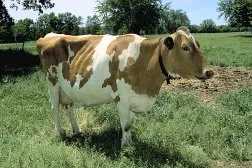A Swiss Paradox?
Gstaad, Switzerland, has gained renown for its challenging ski trails and celebrity sightings. Come summer, however, the area’s slopes host cows, not skiers. It now appears that milk from those cows produces cheeses rich in some heart-healthy nutrients.

Mention omega-3 fats and most people think of fish. Indeed, oily fish from cold ocean waters offer an especially rich source of these heart-healthy fats, which is why the American Heart Association recommends including fish in your diet.
However, some plants also produce omega-3 fats in abundance. The carbon-chained backbone of these plant fats tend to be shorter than the 20- and 22-carbon version typical of fish oils, so the omega-3 fats are different. On the other hand, chemical reactions in the body can elongate some plant fats to fishy lengths. Moreover, even at 18 carbons, the plant-derived alpha-linolenic-acid (ALA) omega-3 can contribute to heart health, research has shown.
In general, cheeses are fatty foods. However, Jürg H. Beer of the Canton Hospital in Baden, Switzerland, and his colleagues now report finding that cheeses produced in alpine areas around Gstaad hold a more heart-healthy mix of fats than do cheeses made from the milk of cows grazing at lower altitudes. Not only were alpine cheeses highest in omega-3 fats, such as ALA, but they also had relatively low concentrations of saturated fats and arachidonic acid, a fatty acid that can promote inflammation in the body. As an unanticipated benefit, cheeses made from the milk of grass-fed alpine cows exhibited the highest concentrations of the unusual trans fatty acid, conjugated linoleic acid, that a number of studies have linked with cancer prevention.
Beer acknowledged to Science News Online that even alpine cheeses “can’t compete with fish” as a source of omega-3 fatty acids. The plant-derived omega-3s aren’t as abundant nor as consistently of the preferred length as the fatty acids from fish are. However, Beer notes, for people concerned about mercury contamination of fish or who just like cheese, alpine varieties appear to be a heart-healthy choice.
Beer’s team reports its new findings in the Jan. 6, 2004 Circulation.
The alpine answer to the French paradox?
Over the years, many studies have highlighted a conundrum: Though the typical French diet contains large amounts of butter, cream, and other foods rich in typically artery-clogging saturated fats, the French incidence of fatal heart attacks is low. To tease out why, epidemiologists have probed other aspects of the regional cuisine. At present, the leading candidate to explain what has come to be known as the French paradox is wine–a beverage that’s a Gallic favorite and rich in heart-sparing antioxidants.
Beer notes that alpine regions also have developed a reputation for longevity–something the locals attribute to their dairy-rich diet. Realizing that the grass-fed livestock might be grazing on omega-3–endowed plants, the internist decided to collaborate with the Federal Institute of Technology in Zurich to profile the fats in various cheeses.
Altogether, the researchers sampled 12 alpine cheeses from the Gstaad region, 7 commercially made English Cheddars, 6 cheeses from cows whose diets had been supplemented with omega-3–rich linseeds, 7 commercially made Emmentalers (what North Americans refer to as Swiss cheese), and 8 alpine cheeses made from the milk of cows that had received silage corn. The alpine cheeses are traditionally hard cheeses, unlike typical Emmentalers or Cheddars.
The researchers observed a trend. Cheeses from the milk of purely grass-fed alpine cows had the best fat profile, followed by cheeses from silage-fed alpine cows and linseed-supplemented cows. Lowest in omega-3 fatty acids were the Emmentalers and then the Cheddars. Grass-based alpine cheese contained four times as much of the plant omega-3 ALA as did the Cheddar, more omega-3 fats in general, three times as much conjugated linoleic acid, and 20 percent less of the saturated fat palmitic acid.
“Surprisingly,” Beer’s team notes, cheese from the milk of cows getting the linseed omega-3 supplement contained only half as much ALA as did cheeses from grass-fed alpine cows. Emmentalers contained only 40 percent as much of this omega-3 fatty acid as alpine cheeses did.
Most people living in industrialized countries consume an average of 55 grams of cheese per day, the researchers say. That much Cheddar would supply 62 milligrams of ALA daily–a mere 22 percent as much as an equivalent amount of alpine cheese. In other words, just swapping one cheese for the other could increase daily ALA consumption by 210 milligrams. The Swiss researchers cite data from a 1999 Harvard study indicating that increasing the ALA content of the U.S. diet by 210 milligrams per day might cut the population’s risk of fatal heart attacks by 15 to 20 percent.
To test whether the ALA-rich alpine cheeses actually translate into beneficial changes in heart risk for people, Beer’s team has begun a year-long study with local volunteers. If alpine cheeses indeed prove heart healthy, the researchers say they’ll next try to answer the important questions of what aspects of climate, altitude, and livestock diet contribute to the dairy products’ unusual fat profile.







